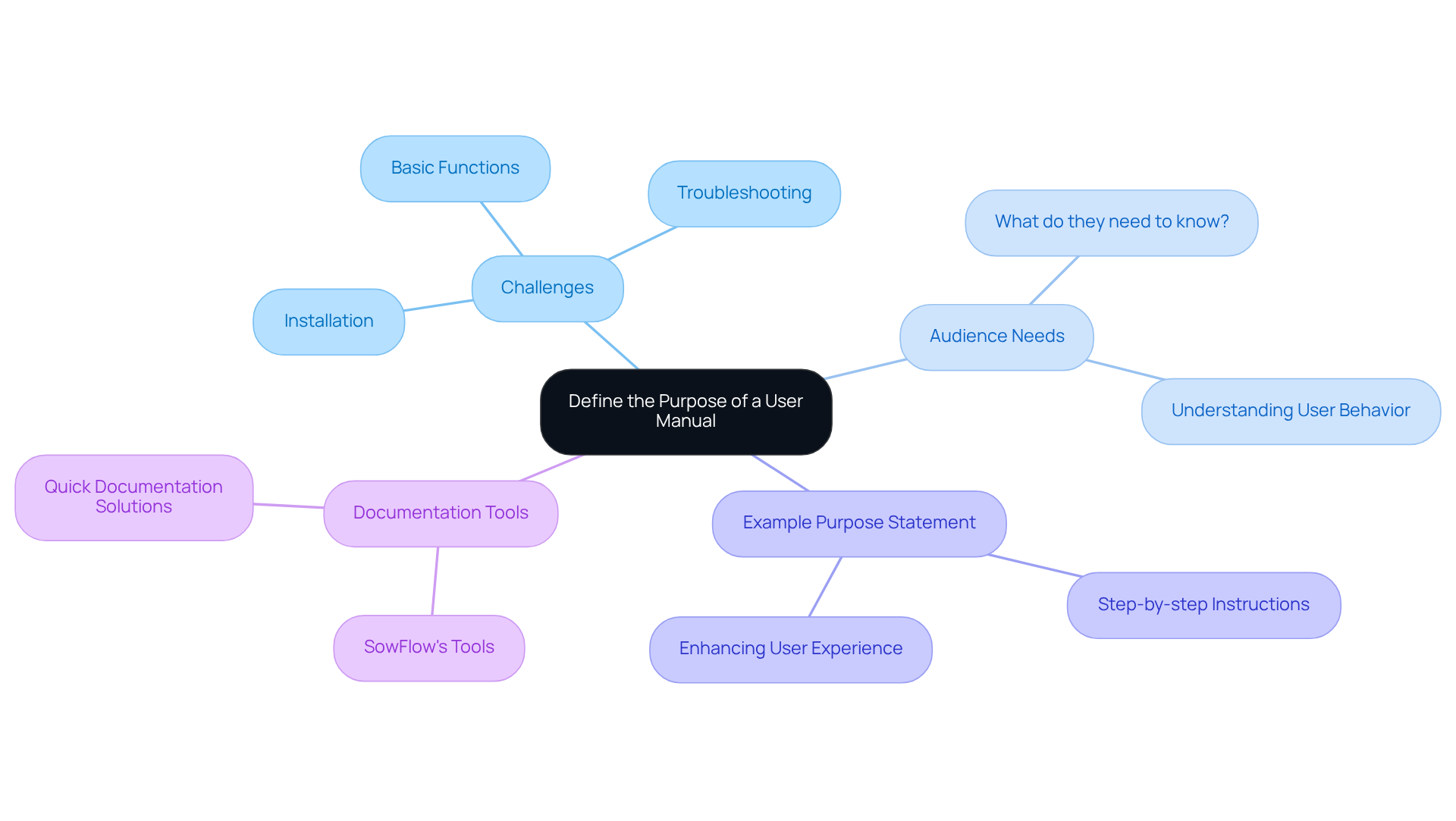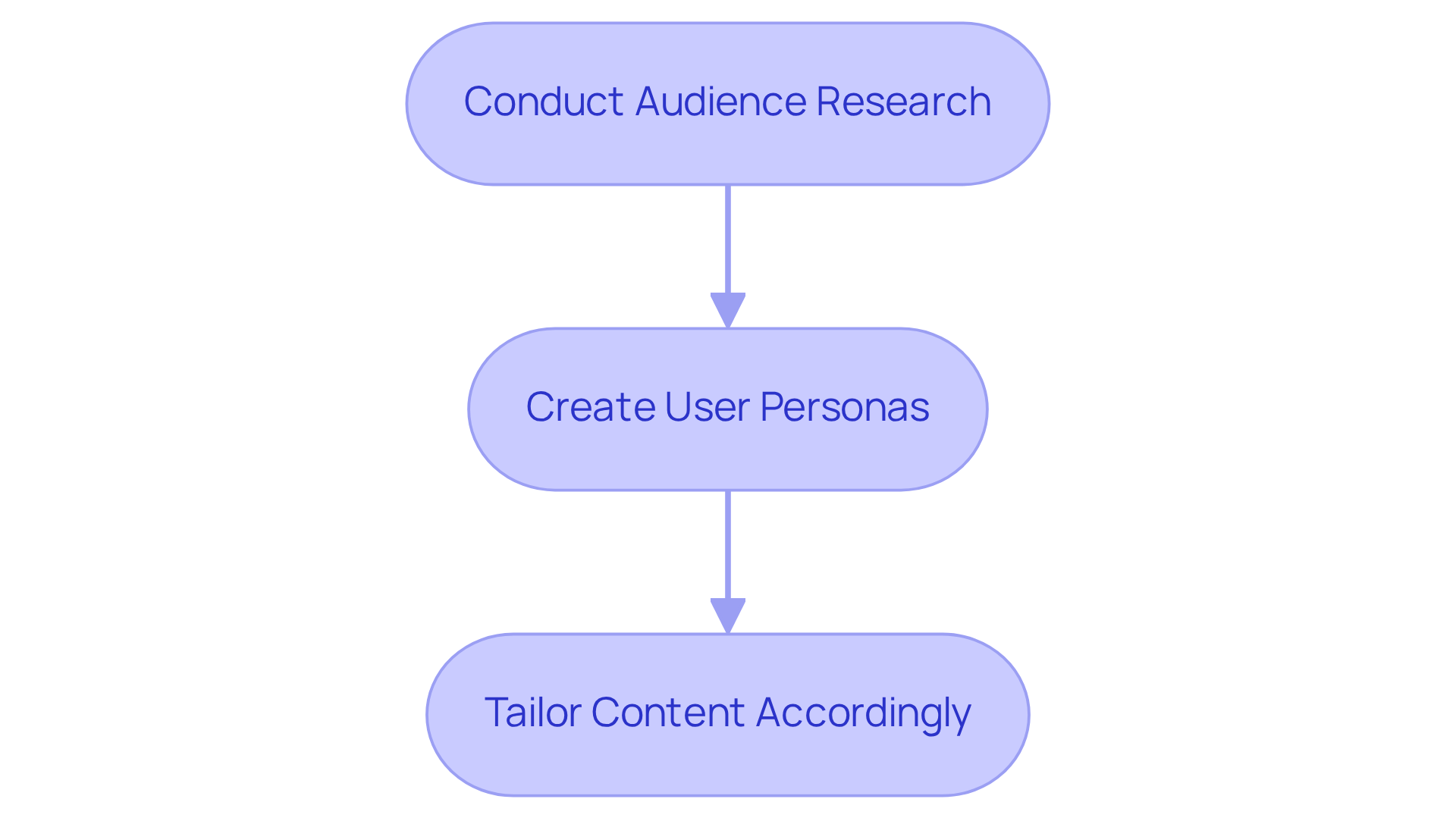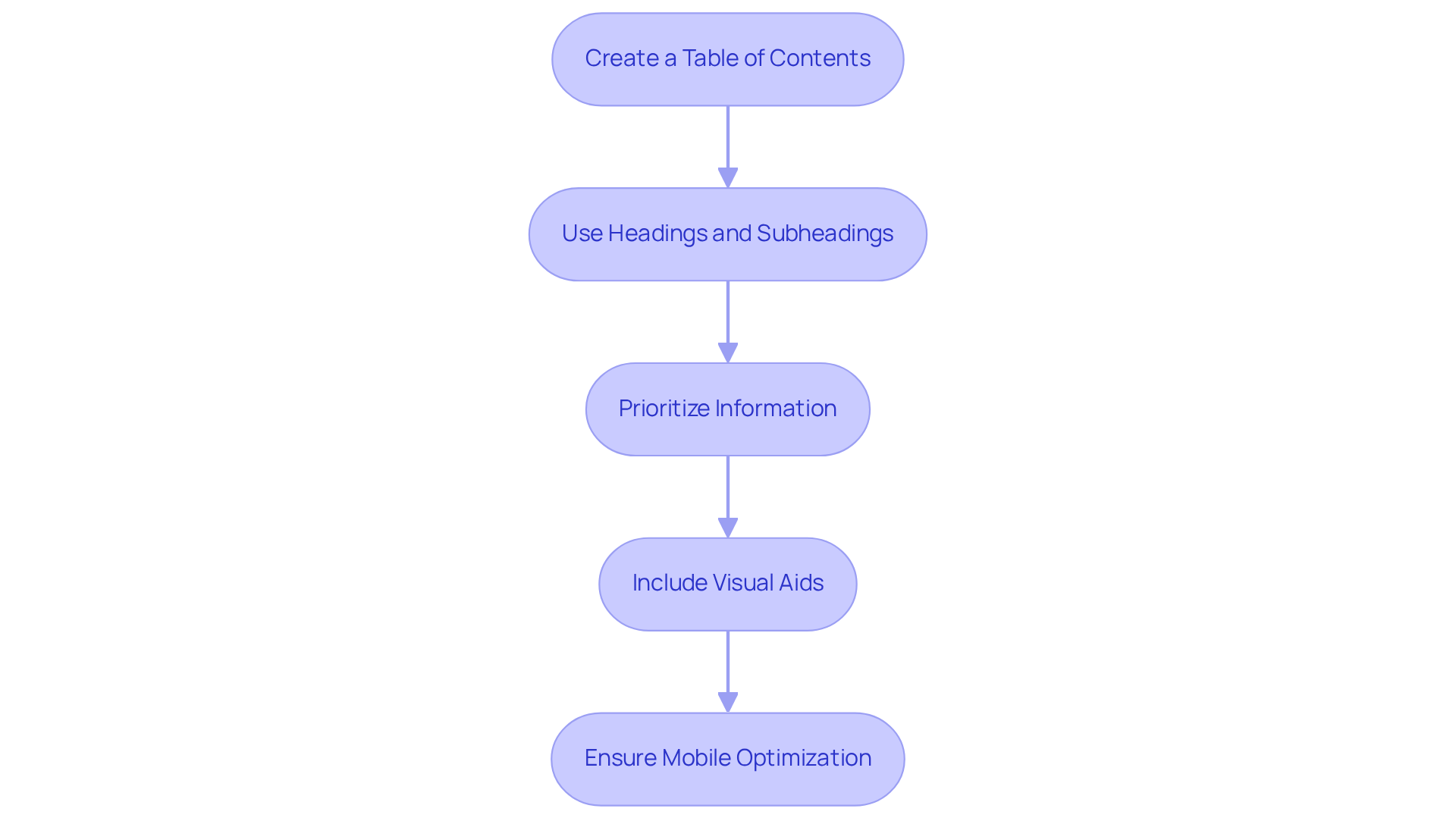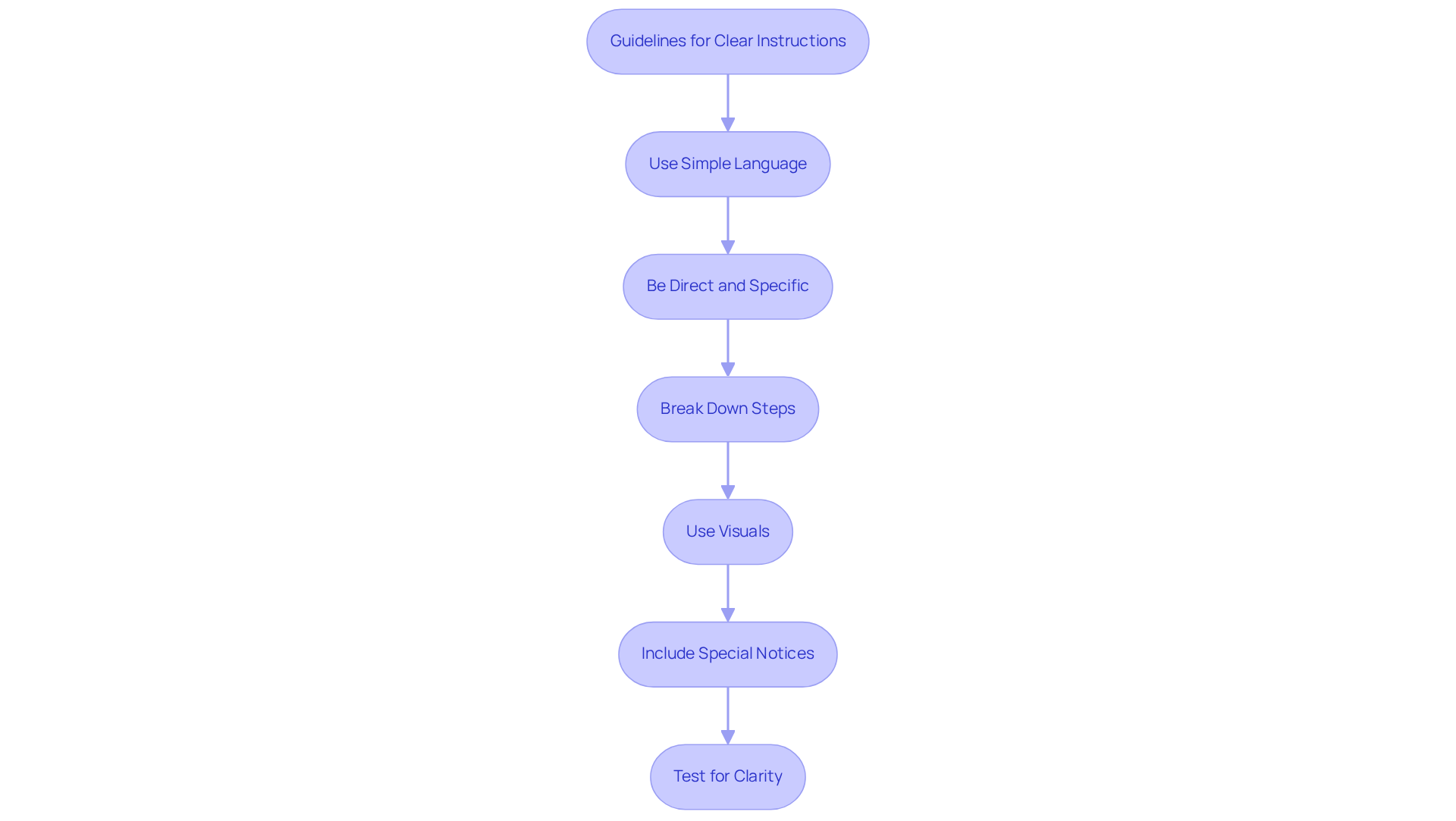
Overview
You might be wondering how to whip up an effective user manual. Well, it all starts with defining the manual's purpose. Next, you’ll want to dive into some audience research. This helps you organize your content clearly, using simple language and visuals that really resonate with your users.
Now, let’s break it down a bit. Think about developing user personas—who are you writing for? Prioritizing information is key, too. You want to make sure the most important stuff stands out. And don’t forget about usability testing! This step is crucial to ensure your manual meets user needs and stays relevant over time.
So, as you embark on this journey, keep these steps in mind. They’ll not only help you create a user manual that’s effective but also one that your audience will appreciate and find useful.
Key Highlights:
- Define the purpose of the user manual by identifying specific challenges and understanding the target audience's needs.
- Conduct audience research through surveys and interviews to gather data on demographics and technical skills.
- Create user personas to represent different audience segments and tailor content accordingly.
- Organise content with a clear structure, including a table of contents, headings, and prioritisation of information.
- Use simple language and direct commands to write clear and concise instructions, breaking down complex tasks into manageable steps.
- Incorporate visuals to enhance understanding and engagement, as they significantly improve retention of information.
- Conduct usability testing with real users to identify and address usability issues in the manual.
- Gather and analyse feedback to refine the manual, ensuring it remains relevant and effective.
- Revise the manual based on user feedback and adopt an ongoing process of testing and updating.
Introduction
Creating an effective user manual is a must for operations managers, but let’s be honest—many of us don’t even know where to start. You might be wondering, how do you define a clear purpose and really understand your target audience? Well, that’s the key to making sure your manuals not only inform but also enhance the user experience.
But here’s the kicker: balancing clarity with comprehensive content can feel like a juggling act. How can you craft a guide that’s both detailed and user-friendly? This article dives into the essential steps for putting together a user manual that meets the needs of all kinds of users while keeping things clear and engaging. So, let’s get started!
Define the Purpose of a User Manual
You might be wondering how to kick off your guide effectively. Start by tackling some essential questions:
- What specific challenges are you looking to resolve?
- Who’s your audience, and what do they really need to know?
For example, if you’re crafting a guide for a software application, your goal could be to help folks with installation, basic functions, and troubleshooting common issues.
Now, with a quick documentation solution, you can whip up guides that not only hit these marks but also allow for speedy updates. This way, your material stays relevant in a fast-paced business world. A clear purpose statement could look something like this:
'This how to user manual provides step-by-step instructions for installing and using [Product Name], along with troubleshooting tips to enhance your experience.'
This kind of clarity, paired with SowFlow's tools that cut down on unnecessary meetings and streamline the documentation process, will really guide your content creation. Plus, it keeps the focus on what your audience needs throughout the journey.

Identify Your Target Audience
You might be wondering how to identify your target audience, right? Well, let’s break it down into some simple steps that can really help you out.
-
Conduct Audience Research: Start by gathering data on potential participants. You can use surveys, interviews, or focus groups to get a feel for their demographics, technical skills, and specific needs. For instance, did you know that 56% of EU citizens aged 16-74 have at least basic digital skills? This shows there’s a wide range of technical abilities out there. It’s a good reminder that we need to tackle the digital skills gap, especially since the EU is aiming for 80% by 2030.
-
Create User Personas: Next up, think about developing detailed profiles that represent different segments of your audience. What are their goals, challenges, and preferences? For example, you might have a persona like 'New User': a beginner who’s not too tech-savvy and needs clear, jargon-free instructions. This really highlights why it’s important to use the how to user manual to tailor your content to meet various audience needs.
-
Tailor Content Accordingly: Now, use those insights to tweak the language, tone, and complexity of your guide. If your audience includes both beginners and seasoned pros, consider creating separate sections in the how to user manual or appendices for each group. This way, everyone can easily navigate the guide, making their experience much smoother.
So, what do you think? Ready to dive into understanding your audience better?

Organize Content with Clear Structure
To effectively arrange your material with SowFlow's innovative tools, let’s break it down into some easy steps:
-
Create a Table of Contents: You might be wondering where to start. A detailed how to user manual serves as your best friend here! It outlines the main sections and subsections of your manual, acting like a roadmap for anyone who picks it up. With SowFlow, creating this is a breeze, and it keeps your guides fresh and up-to-date. Studies show that folks really appreciate a well-defined outline—it helps them find what they need quickly.
-
Use Headings and Subheadings: Next up, let’s talk about structure. Dividing your material into bite-sized sections with clear headings and subheadings makes a world of difference. Think about main sections like 'Installation,' 'Basic Operations,' and 'Troubleshooting.' This not only helps with understanding but also aligns with how users prefer organized material. Plus, SowFlow makes it super easy to tweak things whenever you need to.
-
Prioritize Information: Now, how do you decide what goes where? Start with the essentials and gradually move to the more complex stuff. Using bullet points, numbered lists, and visuals can really boost clarity and keep people engaged. Research shows that when content is organized to lighten the cognitive load, it helps individuals focus on what’s important. With this approach, you can easily revise and prioritize your documentation to keep it relevant.
-
Include Visual Aids: Let’s not forget about visuals! Diagrams, screenshots, or flowcharts can really illustrate processes and enhance understanding. Did you know that articles with images get 94% more views? SowFlow’s platform supports seamless integration of these visual aids, making your guides not just informative but also engaging. This organized method will make your how to user manual more approachable and user-friendly, ultimately enhancing the experience for everyone.
And hey, considering that 61% of people won’t return to a site that isn’t mobile-friendly, make sure your documentation is optimized for mobile use. Incorporating the TOC and Index functionality can also clarify the process of creating logically sound documents, improving usability and simplifying future documentation maintenance. So, what do you think? Ready to dive in?

Write Clear and Concise Instructions
Crafting clear and concise instructions with SowFlow's innovative documentation tools can be a breeze if you follow these essential guidelines:
-
Use Simple Language: You might be wondering why this matters. Well, it’s all about clarity! Ditch the jargon and technical terms unless you absolutely have to use them. And if you do, make sure to provide definitions or explanations. Research shows that 80% of folks prefer sentences in plain English, especially when tackling complex topics.
-
Be Direct and Specific: Let’s get straight to the point! Use active voice and direct commands. Instead of saying, 'The individual should click on the button,' just say, 'Click the button.' This little tweak can really boost clarity and cut down on confusion.
-
Break Down Steps: Got a complex task? No problem! Break it down into smaller, manageable steps. Number each step to guide users through the process logically. This not only simplifies things but also aligns with findings that show how a user manual can help learners remember information better when it’s presented clearly and structured. Plus, with SowFlow, updating these steps is a snap, so you can keep everything relevant without endless meetings.
-
Use Visuals: Speaking of clarity, visuals can be a game-changer! Whenever you can, add visuals to your written instructions. Screenshots with arrows pointing out relevant buttons or features can make a huge difference. Research indicates that up to 80% of people learn and retain information better with visuals. And guess what? Learners spend 40% more time focusing on animated elements compared to static images, which can really amp up engagement. SowFlow makes it easy to integrate high-quality visuals seamlessly.
-
Include Special Notices: Don’t forget to add special notices or warnings! These are crucial for keeping everyone safe during procedures. It’s all about effective instruction writing and participant safety.
-
Test for Clarity: After you’ve drafted your instructions, have someone who’s unfamiliar with the product take a look. Their fresh perspective can help you spot any areas that need clarification. This step is super important because testing your guidelines with real participants can reveal insights into how effective and usable they really are.
Remember, as Jean Cocteau said, 'Style is a simple way of saying complicated things.' With SowFlow, you can streamline this entire process, making documentation creation and updates effortless. So, why not give the how to user manual a try?

Test and Revise Based on User Feedback
To effectively test and revise your instructional guide, let’s break it down into some easy steps:
-
Conduct Usability Testing: You might be wondering how to start. Well, pick a group of folks who represent your audience and have them try out the tasks you’ve laid out in the how to user manual. Keep an eye on how they interact with it and note any hiccups they face. Did you know that studies show you can uncover about 85% of usability issues with just five testers? That’s why this step is super important for spotting problems early on.
-
Gather Feedback: Now, let’s talk feedback. Use surveys or interviews to get insights from your participants about their experience with the manual. Ask them specific questions about clarity, usability, and any confusing bits. Trust me, effective feedback collection is essential in the how to user manual to boost the quality of your documentation.
-
Analyze Results: Once you’ve gathered feedback, it’s time to dig in. Look for common issues or suggestions that pop up. Are there patterns showing where people struggle the most? For example, if you notice a high error rate during task completion, that’s a red flag for usability challenges that need fixing. A great case study to consider is NOWJOBS, which saw task success rates between 73% and 100% thanks to their usability testing. Pretty impressive, right?
-
Revise the Manual: Based on what you’ve learned, it’s time to roll up your sleeves and make some changes. Revise the content, structure, or instructions as needed. Just make sure those changes are reflected in the how to user manual to tackle the issues you’ve identified. Quality revisions can lead to happier users and better retention.
-
Repeat the Process: Finally, remember that testing and revising isn’t a one-and-done deal. It should be an ongoing process. Keep refreshing the manual based on recent feedback and any changes in your product or processes. Continuous iteration is key! Organizations that act on usability research often see much better outcomes, so don’t underestimate the power of ongoing testing and revisions.
As Pratyusha Guha wisely points out, "Ensure they can easily find what they’re searching for." This really highlights how crucial user feedback is in this whole process.

Conclusion
Creating a user manual? It’s a pretty essential task that can really boost the user experience and make operations run smoother. By clearly defining what the manual is for, figuring out who it’s aimed at, organizing the content well, and writing clear instructions, operations managers can whip up valuable resources that empower users and cut down on confusion. This structured approach makes sure the manual does its job, giving users the guidance they need to navigate products or processes with ease.
You might be wondering how to craft an effective user manual. Well, the article lays out some critical steps, like doing audience research, creating user personas, and prioritizing information to make things clearer. And let’s not forget about usability testing and gathering user feedback—these practices are key! They lead to continuous improvements and help keep the manual relevant and user-friendly. Each of these components is vital in developing a comprehensive guide that meets the diverse needs of its audience.
Ultimately, a well-crafted user manual is more than just documentation; it helps people understand products and services better, boosting overall satisfaction and productivity. By focusing on clarity and organization while staying open to user feedback, operations managers can create manuals that serve as instructional tools and vital resources for ongoing learning and improvement. So, why not embrace these best practices? Transform your user manuals into indispensable assets for your organization!
Frequently Asked Questions
What is the purpose of a user manual?
The purpose of a user manual is to provide clear instructions for resolving specific challenges, informing the audience about essential information they need to know, such as installation, basic functions, and troubleshooting tips for a product.
How can I effectively define the purpose of my user manual?
To define the purpose of your user manual, start by identifying the specific challenges you want to resolve and understanding your audience's needs. A clear purpose statement can guide content creation and ensure it remains relevant.
What steps should I take to identify my target audience for a user manual?
To identify your target audience, conduct audience research using surveys, interviews, or focus groups to gather data on demographics, technical skills, and specific needs.
What are user personas, and how do they help in creating a user manual?
User personas are detailed profiles representing different segments of your audience, including their goals, challenges, and preferences. They help tailor the content of the user manual to meet the diverse needs of the audience.
How can I tailor the content of my user manual to different audience segments?
You can tailor the content by adjusting the language, tone, and complexity based on audience insights. Consider creating separate sections or appendices for different user groups, such as beginners and experienced users, to enhance navigation and usability.
Why is it important to consider the digital skills gap when creating a user manual?
Considering the digital skills gap is important because it ensures that the manual is accessible to users with varying levels of technical abilities. This approach helps to meet the needs of a wider audience and enhances overall user experience.
👍
What others are liking
5 Steps to outline your ideal documentation structure
5 MINS READ
Where to start the your journey of mapping out your ideal documentation structure, aligning it with the very heartbeat of your organization?
Defining a winning level of detail in your process
3 MINS READ
What is too much detail, and what is too little? This article described in that winning level detail about what detail is enough.





